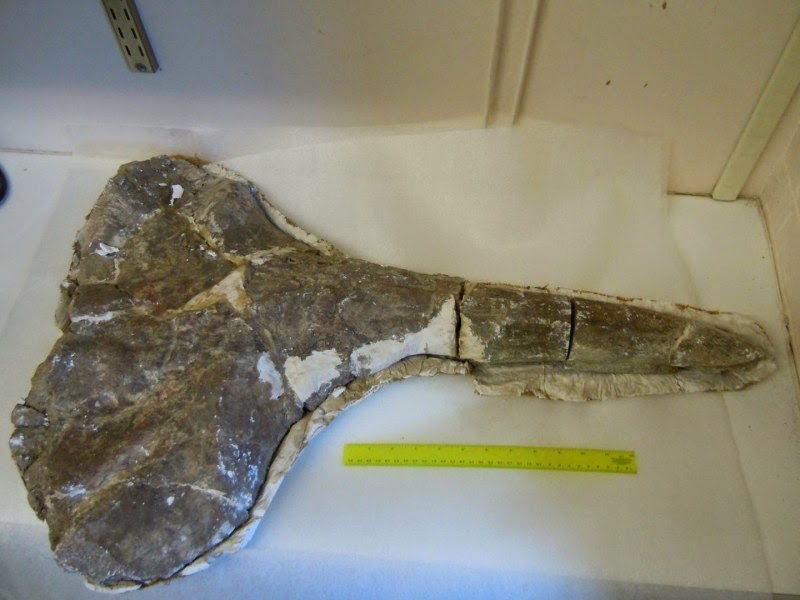
Uplift associated with the Great Rift Valley of East Africa and the environmental changes it produced have puzzled scientists for decades because the timing and starting elevation have been poorly constrained.
Now paleontologists have tapped a fossil from the most precisely dated beaked whale in the world — and the only stranded whale ever found so far inland on the African continent — to pinpoint for the first time a date when East Africa’s mysterious elevation began.
The 17 million-year-old fossil is from the beaked Ziphiidae whale family. It was discovered 740 kilometers inland at an elevation of 620 meters in modern Kenya’s harsh desert region, said vertebrate paleontologist Louis L. Jacobs, Southern Methodist University, Dallas.
At the time the whale was alive, it would have been swimming far inland up a river with a low gradient ranging from 24 to 37 meters over more than 600 to 900 kilometers, said Jacobs, a co-author of the study.
The study, published in the Proceedings of the National Academy of Sciences, provides the first constraint on the start of uplift of East African terrain from near sea level.
“The whale was stranded up river at a time when east Africa was at sea level and was covered with forest and jungle,” Jacobs said. “As that part of the continent rose up, that caused the climate to become drier and drier. So over millions of years, forest gave way to grasslands. Primates evolved to adapt to grasslands and dry country. And that’s when — in human evolution — the primates started to walk upright.”
Identified as a Turkana ziphiid, the whale would have lived in the open ocean, like its modern beaked cousins. Ziphiids, still one of the ocean’s top predators, are the deepest diving air-breathing mammals alive, plunging to nearly 10,000 feet to feed, primarily on squid.
In contrast to most whale fossils, which have been discovered in marine rocks, Kenya’s beached whale was found in river deposits, known as fluvial sediments, said Jacobs, a professor in the Roy M. Huffington Department of Earth Sciences of SMU’s Dedman College of Humanities and Sciences. The ancient large Anza River flowed in a southeastward direction to the Indian Ocean. The whale, probably disoriented, swam into the river and could not change its course, continuing well inland.
“You don’t usually find whales so far inland,” Jacobs said. “Many of the known beaked whale fossils are dredged by fishermen from the bottom of the sea.”
Determining ancient land elevation is very difficult, but the whale provides one near sea level.
“It’s rare to get a paleo-elevation,” Jacobs said, noting only one other in East Africa, determined from a lava flow.
Beaked whale fossil surfaced after going missing for more than 30 years
The beaked whale fossil was discovered in 1964 by J.G. Mead in what is now the Turkana region of northwest Kenya.
Mead, an undergraduate student at Yale University at the time, made a career at the Smithsonian Institution, from which he recently retired. Over the years, the Kenya whale fossil went missing in storage. Jacobs, who was at one time head of the Division of Paleontology for the National Museums of Kenya, spent 30 years trying to locate the fossil. His effort paid off in 2011, when he rediscovered it at Harvard University and returned it to the National Museums of Kenya.
The fossil is only a small portion of the whale, which Mead originally estimated was 7 meters long during its life. Mead unearthed the beak portion of the skull, 2.6 feet long and 1.8 feet wide, specifically the maxillae and premaxillae, the bones that form the upper jaw and palate.
The researchers reported their findings in “A 17 million-year-old whale constrains onset of uplift and climate change in East Africa” online at the PNAS web site.
Modern cases of stranded whales have been recorded in the Thames River in London, swimming up a gradient of 2 meters over 70 kilometers; the Columbia River in Washington state, a gradient of 6 meters over 161 kilometers; the Sacramento River in California, a gradient of 4 meters over 133 kilometers; and the Amazon River in Brazil, a gradient of 1 meter over 1,000 kilometers.
Reference:
Henry Wichura, Louis L. Jacobs, Andrew Lin, Michael J. Polcyn, Fredrick K. Manthi, Dale A. Winkler, Manfred R. Strecker, Matthew Clemens. A 17-My-old whale constrains onset of uplift and climate change in east Africa. Proceedings of the National Academy of Sciences, 2015; 201421502 DOI: 10.1073/pnas.1421502112
Note: The above story is based on materials provided by Southern Methodist University.










